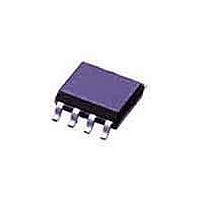TJA1020TD NXP Semiconductors, TJA1020TD Datasheet - Page 6

TJA1020TD
Manufacturer Part Number
TJA1020TD
Description
RF Transceiver LIN TRANSCEIVER
Manufacturer
NXP Semiconductors
Datasheet
1.TJA1020TD.pdf
(22 pages)
Specifications of TJA1020TD
Number Of Receivers
4
Number Of Transmitters
3
Operating Supply Voltage
5 V to 27 V
Maximum Operating Temperature
+ 150 C
Mounting Style
SMD/SMT
Package / Case
SO-8
Maximum Data Rate
0.02 MBd
Maximum Supply Current
8 mA
Minimum Operating Temperature
- 40 C
Lead Free Status / RoHS Status
Lead free / RoHS Compliant
Other names
TJA1020T/N1,112
Philips Semiconductors
Setting pin NSLP HIGH during standby mode results in the
following events:
Normal slope mode
In the normal slope mode the transceiver is able to
transmit and receive data via the LIN bus line. The receiver
detects the data stream at the LIN bus input pin and
transfers it via pin RXD to the microcontroller (see Fig.1):
HIGH at a recessive level and LOW at a dominant level on
the bus. The receiver has a supply voltage related
threshold with hysteresis and an integrated filter to
suppress bus line noise. The transmit data stream of the
protocol controller at the TXD input is converted by the
transmitter into a bus signal with controlled slew rate and
wave shaping to minimize EME. The LIN bus output pin is
pulled HIGH via an internal slave termination resistor. For
a master application an external resistor in series with a
diode should be connected between pin INH or BAT on
one side and pin LIN on the other side (see Fig.7).
Being in the sleep or standby mode, the TJA1020 enters
normal slope mode whenever a HIGH level on pin NSLP is
maintained for a time of at least t
preceding positive edge is executed while pin TXD is
already set to HIGH.
The TJA1020 switches to sleep mode in case of a LOW
level on pin NSLP, maintained during a certain time period
(t
Low slope mode
The only difference between the normal slope mode and
the low slope mode is the transmitter behaviour.
2004 Jan 13
gotosleep
An immediate reset of the wake-up source flag; thus
releasing the possible strong pull-down at pin TXD
before the actual mode change (after t
performed
A change into normal slope mode if the HIGH level on
pin NSLP has been maintained for a certain time period
(t
A change into low slope mode if the HIGH level on pin
NSLP has been maintained for a certain time period
(t
deliberately driven by the microcontroller, or due to a
failure. In the event of a short-circuit to ground or an
open-wire on pin TXD, the LIN output remains recessive
(fail safe)
A reset of the wake-up request signal on pin RXD if the
HIGH level on pin NSLP has been maintained for a
certain time period (t
LIN transceiver
gotonorm
gotonorm
) while pin TXD is already set to HIGH.
) while pin TXD is pulled HIGH
) while pin TXD is pulled LOW either
gotonorm
).
gotonorm
gotonorm
provided its
) is
6
In the low slope mode the transmitter output stage drives
the LIN bus line with lengthened rise and fall slopes. This
will further reduce the already outstanding EME in the
normal slope mode. The low slope mode is perfectly suited
for applications where transmission speed is not critical.
The mode selection is done by the LIN transceiver after a
positive edge on pin NSLP, maintained for a certain time
period (t
slope mode is entered, otherwise the normal mode is
entered. The transition to the low slope mode will be
executed during an open pin TXD (fail-safe), a short-circuit
from pin TXD to ground (fail-safe) or an intended LOW
level of pin TXD programmed by the microcontroller. The
transmitter is enabled after a LOW-to-HIGH transition on
pin TXD. In the event of a short-circuit to ground on pin
TXD, the transmitter will be disabled.
Wake-up
There are three ways to wake-up a TJA1020 which is in
sleep mode:
1. Remote wake-up via a dominant bus state
2. Local wake-up via a negative edge at pin NWAKE
3. Mode change (pin NSLP is HIGH) from sleep mode to
Remote and local wake-up
A falling edge at pin NWAKE followed by a LOW level
maintained for a certain time period (t
local wake-up. The pin NWAKE provides an internal
pull-up towards pin BAT. In order to prevent EMI issues, it
is recommended to connect an unused pin NWAKE to
pin BAT.
If, during power-up, pin NWAKE is LOW for a certain
period of time (t
wake-up.
A falling edge at pin LIN followed by a LOW level
maintained for a certain time period (t
edge at pin LIN respectively (see Fig.4) results in a remote
wake-up.
After a local or remote wake-up pin INH is activated (it
goes HIGH) and the internal slave termination resistor is
switched on. The wake-up request is indicated by a LOW
active wake-up request signal on pin RXD to interrupt the
microcontroller.
normal slope/low slope mode.
gotonorm
). If pin TXD is LOW at that time, the low
NWAKE
) this will also result in a local
Product specification
NWAKE
BUS
) and a rising
TJA1020
) results in a















